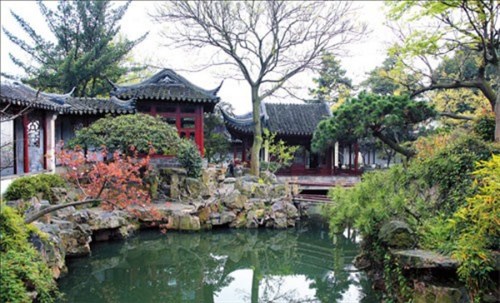Reconnect with childhood at Suzhou gardens
 0 Comment(s)
0 Comment(s) Print
Print E-mail Shanghai Daily, July 2, 2015
E-mail Shanghai Daily, July 2, 2015
Dubbed "Garden City" and "Venice of the East" in the past, Suzhou is still today a water town of timeless beauty. Famous for its ancient canals, bridges and traditional gardens, the city provides a glimpse into long-lived Chinese tradition and sophistication.
This ancient silk capital was always associated with high culture and elegance. During its glory days in the 14th century, it attracted generations of scholars, artists and writers who sought inspiration and pleasure.
Ancient poetry is still alive — in the reflection of a pavilion in the water, in the delicacy of the gardens and in traditional architecture. The visitor only needs to look closely and decrypt the signs.
With its 2,500 years history, Suzhou is a rare opportunity to travel into the past and get a real impression of the exceptional culture and tradition of China.
With its sweet fragrance and beautiful Zoo on an island, Suzhou also seems like a fairytale that takes the visitor back into childhood.
One cannot live or travel in Suzhou without taking the time to visit this multi-faceted city, its renowned gardens and get lost in the tiny streets of the historic center while tasting some regional delicacies.
Ou Garden retreat
Located in the historical part of Suzhou, a few meters away from the popular canal side street, Pingjiang Road, Ou Garden is less frequented than other traditional gardens in the city. And yet, its layout and romantic atmosphere are truly unique. Its beautiful courtyards, splendid pavilions and water pounds all stand for the dreamy feel of this oasis. The whole place is blessed with a serene charm explained by its passionate history.
The Ou Garden was originally laid out to become the private garden of Lu Jin, a Qing Dynasty (1644-1911) official. At that time it was called She Garden. Destroyed by wars, it was reconstructed and extended in 1874 by Shen Bincheng, a retired governor of Anhui Province. This is when the garden gained its poetic touch and was renamed "The Couple's Garden Retreat" alluding to the governor and his wife who ended their days in the tranquility of this garden. Each detail in the place is emblematic of this couple's mutual love and of their admiration for Chinese culture.
The garden is also called Ou because in Chinese, the name lotus is synonym with couple, thus evoking a couple's harmony. It was opened to the public in May 1965.
Embraced by waterways on three sides, the Couple's Garden is the only one in Suzhou that is surrounded by the river. The journey to the garden starts with a scenic ride on board a traditional wooden boat. Here, time-honored architecture and ancient houses can be admired from the side of the canal. Lulled by the gentle sound of water, the visitor slowly begins to fully appreciate the garden's atmosphere.
Even though the garden is rather small (0.8 hectares), the feeling it conveys to the visitor is overwhelming. Truly, it is hard not to fall in love with the delicate beauty of this garden.
The Couple's Garden is divided into two parts that are linked by an elevated veranda.
The visit generally starts with the eastern part of the garden, which also used to be the entrance of the property. The two first halls are where the couple received their guests and held occasional diners and ceremonies. The corridors are decorated with poems and calligraphy demonstrating the couple's passion for literature.
A zigzag corridor surrounding a sinuous watercourse mostly characterizes the East Garden.
Still today, the souls of the enamored couple can be felt everywhere. The visitor should use his imagination in order to picture the peaceful life they lived in this romantic nest more than 150 years ago. The long promenade along the corridors feels like walking in the governor and his wife's footsteps, as they held hands.
The pride of the East Garden is the Yellowstone Rockery Mountains. They were assembled by grand master Zhang Nanyang at the end of the Ming Dynasty (1368-1644). This distinctive piece shows that the art of rockery pilling reached its peak in Suzhou.








Go to Forum >>0 Comment(s)